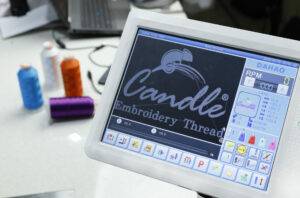Whether you are a fashion designer, embroidery enthusiast, or a professional embroiderer, knowing embroidery digitizing basics is essential. Digitizing is the act of transforming artwork into a digital format. It instructs your machine, on the needle path needed to execute your design.
How To Digitize Embroidery Designs?
Before you dip your toes into digitizing for machine embroidery there are a few things you need to make sure,
Firstly, your computer should be able to support the embroidery software and it should be updated too!
Secondly, you need to determine what file type your embroidery machine supports. Different machines support different file formats. Here is a list of file formats that popular embroidery machines use
Embroidery File Types By Machine
.dst: embroidery file format for Tajima commercial embroidery machines
.exp: embroidery file format for Melco commercial embroidery machines
.jef: embroidery file format for Janome commercial embroidery machines
.kwk: embroidery file format for Brother commercial embroidery machines
.dsb: embroidery file format for Barudan commercial embroidery machines
.tap: embroidery file format for Happy commercial embroidery machines
Once you have figured out the basics we can get to digitizing! Here is a step by step list on how to digitize.
Step 1: Select Your Artwork
This is where the real fun is! You can digitize just about any piece of artwork or image to turn it into your custom thread embroidery design. You can also create the design in the software itself and digitize it.
Step 2: Upload Your Design
Upload your design file (JPG, JPEG, PNG, etc) into the software. Different software accepts different file formats. Crop out unnecessary blank space around the image that you want to be embroidered.
Step 3: Resize Your Design
You need to resize your design to the exact dimensions that will appear on your product. Measure carefully, the space available for embroidery on your product. You can size your image down initially or after you are done digitizing. Resizing after digitizing is helpful when working on a detailed drawing, or a realistic photo illustration.
Step 4: Understand Your Fabric
The fabric on which you plan on using the embroidery machine plays an important role in digitizing. For example; if you are embroidering on a thick cloth, like a towel you may want to incorporate a knock-down stitch into your design.
Step 5: Understand Your Embroidery Thread
You also need to understand your thread, for example, if you are using metallic embroidery thread, you should decrease your stitch density and you should also avoid small stitches and sharp corners in the design.
Different weights of embroidery threads will also make you change the thread density. For example, if you are shifting from a 40-weight embroidery thread to a 30-weight thread you would reduce the thread density and or increase the stitch length.
Step 6: Choose Your Stitch Types
For each area of your design, you will need to specify the type and angle of the stitching. Many software support different fill types, adding variety as well as ease for digitizers. The three most common types of stitches are:
Straight Stitches
In embroidery, straight stitches are used to make straight lines and curves. They are used for:
Shading
Outlines
Detail Work
Fill Stitches Or Tatami Stitches
True to its name, fill stitches fill up the empty spaces of the design. They are used for:
Filling blank spaces
Textured looks
Larger designs
Durable applications
Satin Stitches
Satin stitches are used to add text and brilliant hues to your embroidered designs. They are sewn close together to give borders to the stitched design. Satin stitches are used for:
Words and text
Borders
For achieving a shiny/satin look
Step 7: Test Stitch Out Your Embroidery Design
Before you commit to the design, you should take it for a test run! This will help you tweak any of the digitizing you don’t like.
Tips And Tricks For Digitizing
Here are some tips and tricks to help you save time and energy:
Tip 1: Start Simple
When you are learning to digitize, start with very basic images and work your way up to hard and complicated embroidery designs.
Tip 2: Don’t Rely On Auto-Digitizing
Relying on auto-digitizing can be a bad idea. The software might not always be able to distinguish between the background and the design. This would cause it to assign the same embroidery thread color and stitch angle to both the fabric and the design, resulting in an underwhelming design. It is always best to digitize yourself.
Tip 3: Digitize In The Right Sequence
The embroidery machine should embroider your design in the right sequence. Therefore digitizing should be done in a systematic manner. For example, small details should always be stitched last. Another example would be when you are working with hats and beanies you should start the embroidery from the center and out, to avoid puckering.
Tip 4: Vary Stitch Angle
Vary your stitch angle to make the product look three-dimensional and not bland. A great approach would be to break up large shapes in your design and assign multiple stitch angles to give it depth.
Tip 5: Minimize Jump Stitches
Jump stitches are extra threads left on the embroidery design. To minimize jump stitches, you can add a running stitch from the end of the design to the start of the design. Keep in mind that the color embroidery thread should be the same so that the run stitch is not visible.
Conclusion
Embroidery digitizing may seem like a mammoth task, but it is the basis of your product and it should be done correctly. A well digitized design can be the distinguishing factor between a mediocre product and an excellent product.



